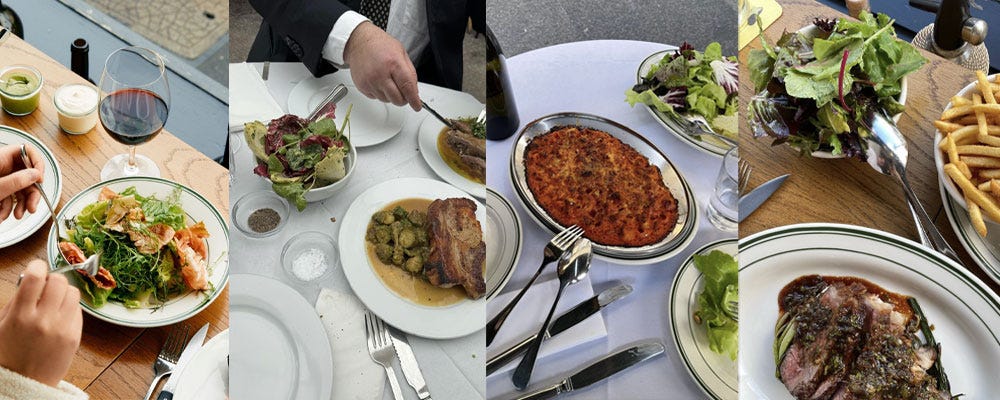I’m not sure how involved you are in the small-time Auckland celebrity social media drama of 2020, but...
A woman with a very large (for NZ) following came out with a cookbook that received a bit of hate, specifically for one recipe.
Now, I haven’t/don’t follow this person because they don’t fit the very specific (mentally healthy) curation of my Instagram feed. But, I’m a white woman in Auckland, of a similar age, and in 2020, I was the prime target audience for Simone Anderson.
By golly, this girl puts in the work. Her content is mind-numbingly fascinating. You could lose hours watching her 50-frame daily, all sponsored, stories. She was everywhere—a little bit for good and a lot for bad (very very bad). I found her incredibly unrelatable and some of her content distasteful but I’ve also never seen someone clean their house quite like her.
I digress.
Her bio states, “Simone Anderson is well known for her stunning weight loss, and her posts focus on food, health, and fashion.” So, in another venture to capitalize on her brand, she wrote a cookbook.
"So Delish!
Super easy, fresh meals for every day. One woman's inspiring story of learning to love yourself."
Boy oh boy did it ruffle some feathers.
Some people were pissed that an influencer was writing a cookbook - why aren’t real chefs getting these opportunities? they cried.
I very much agree, but let’s give more/other women opportunities. I’m pretty sure Nadia Lim has 12 cookbooks but I’d pay big bucks for one from someone like Plabita Florence.
Others didn’t like that she’d called herself a platter queen—I don’t know about you, but I too am the platter queen in my house. Mostly though, people were annoyed by the simplicity of the recipes, especially one - Frozen grapes.
The Spinoff wrote a scathing article on the whole book, especially this recipe. You can read it here.
I’ve flicked through So Delish! on the clearance shelf at Paperplus (subtle burn) and yes, the recipes are simple. But does that make them bad?
Sometimes the simple things are seen as too elementary to communicate and so are then missed. Like putting grapes on a tray and freezing them.
From there you learn to experiment, like realising they’re super good pierced through a toothpick and used as a garnish for cocktails. Or snipped into small bunches, frozen, and served with good dark chocolate and a sticky wine for dessert (heck put it on a platter, you’re the platter Queen now).
After all, do you know where I learned to do it? Jamie Oliver.
With all that in mind, this week - a recipe for what my family calls, courtesy greens.
You know when you read a recipe and it finishes with something like ‘serve with a side of potatoes/bread/polenta/chips and a green salad’ and you think, ok, tell me more, but that’s the extent of it? Well, this is the green salad you should be serving.
Or when you go to a restaurant and they give you a bowl of glossy salad leaves slicked with dressing to go with your mains? This is that.
A simple salad that’s meant to provide clean, crunchy, tangy relief from the heavy, complex, or rich things on the table.
It’s essentially two parts - salad leaves and dressing.
The salad leaves should be a mix of whatever you can get your hands on. Ideally in varying degrees of textures (cos, butterleaf, romaine, iceburg) and bitterness (watercress, rocket, endive, mesclun, anything red).
I like the dressing to have some oomph so triple down on vinegar, horseradish, and mustard and omit sugar entirely. Add a pinch if you think it needs it - but it doesn’t.
An additional bonus: herbs. Add a handful, and up to half the amount of salad leaves, in soft herbs. Basil, dill, parsley, chives, mint, etc, all work well.
If you want to get ahead, prep your salad leaves and place all your dressing ingredients into the jar. To serve, give the dressing a good shake to emulsify and dress the salad leaves. It’s best when it’s only just been mixed.
Courtesy greens
Ingredients:
3 cups mixed greens - I used some romaine lettuce for crunch and a bag of ‘metro mix’ from Farro which had some bitter red greens, spinach, and watercress
Dressing - this makes about ¼ cup - you may have some leftover, so keep in the jar in the fridge for up to a week.
1 Tbsp white wine vinegar
½ shallot, very finely diced
½ Tbsp jarred horseradish
1 tsp Dijon mustard
Salt and freshly ground black pepper
2 Tbsp olive oil
Remove any rough stalks from the salad leaves and tear them all into bite-sized pieces. Place in a big bowl.
For the dressing, add all the ingredients to a jar. Put the lid on (tightly) and give it a good shake to emulsify.
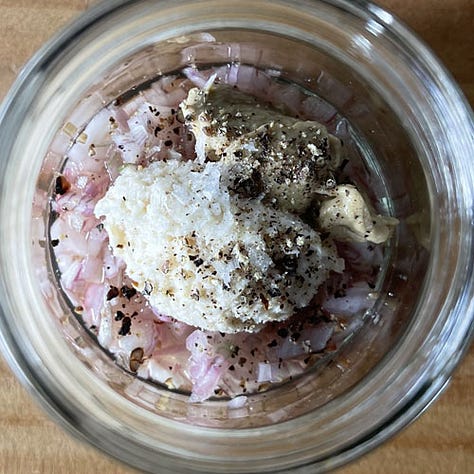
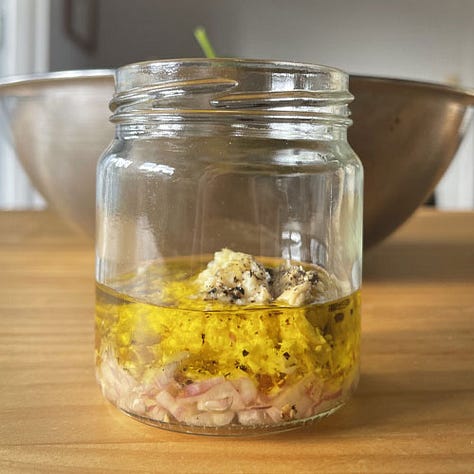
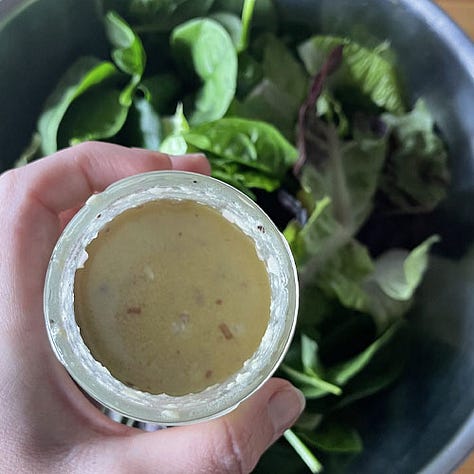
Taste it. Remember that a little is going a long way so the flavours should be pretty punchy. It should be tart, a little fiery, and a bit saltier than you think. Add more vinegar if you think it needs to be more tart, more horseradish, or Dijon to increase the fireyness and salt for - more salt.
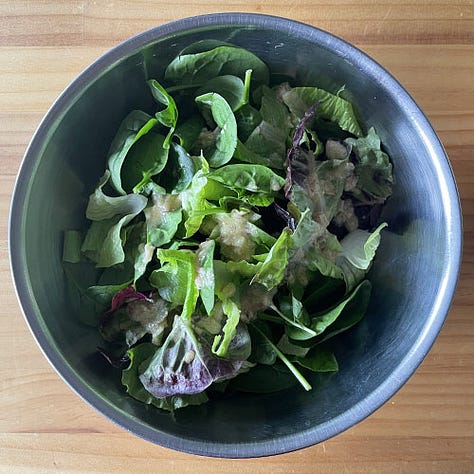

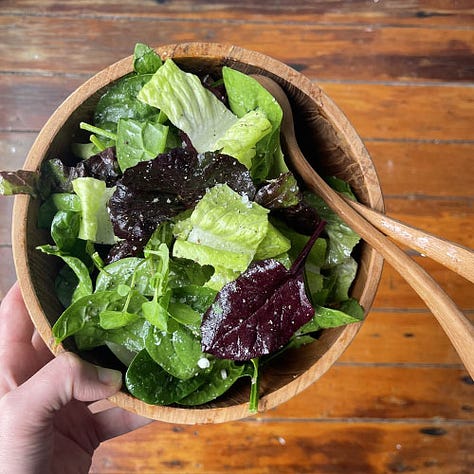
Start by adding 2 Tbsp of the dressing to the salad leaves and, using your hands, toss the salad very well - at least a minute. Try to be gentle and not crush and bruise the leaves.
You want each of the leaves to be coated in the dressing but not saturated by it. If you feel it needs more, add another Tablespoon and mix again.
As soon as it’s mixed, it must be served. Serve it as it is or transfer it into a cute bowl.
We had this salad on Saturday night with this roasted chicken recipe from Julius Roberts - I did two chickens in the original amount of sauce and it worked well. Also, a big batch of potatoes for soaking up said sauce. It would also be great with last week’s roasted chicken and grape recipe.
Eater calls the green salad from Via Carota in NYC ‘an utterly perfect recipe’ and I agree. The choice of lettuce is more specific and the dressing has more ingredients but is worth it. It also has over 4500 5-star reviews in the NY Times which is impressive for a bowl of leaves.
Y’all know I love a big boy vegetable and there are some ripper pumpkins in the store right now. For some inspiration that extends past the classic soup (also good), try:
That’s it, that’s all.
Rosie





